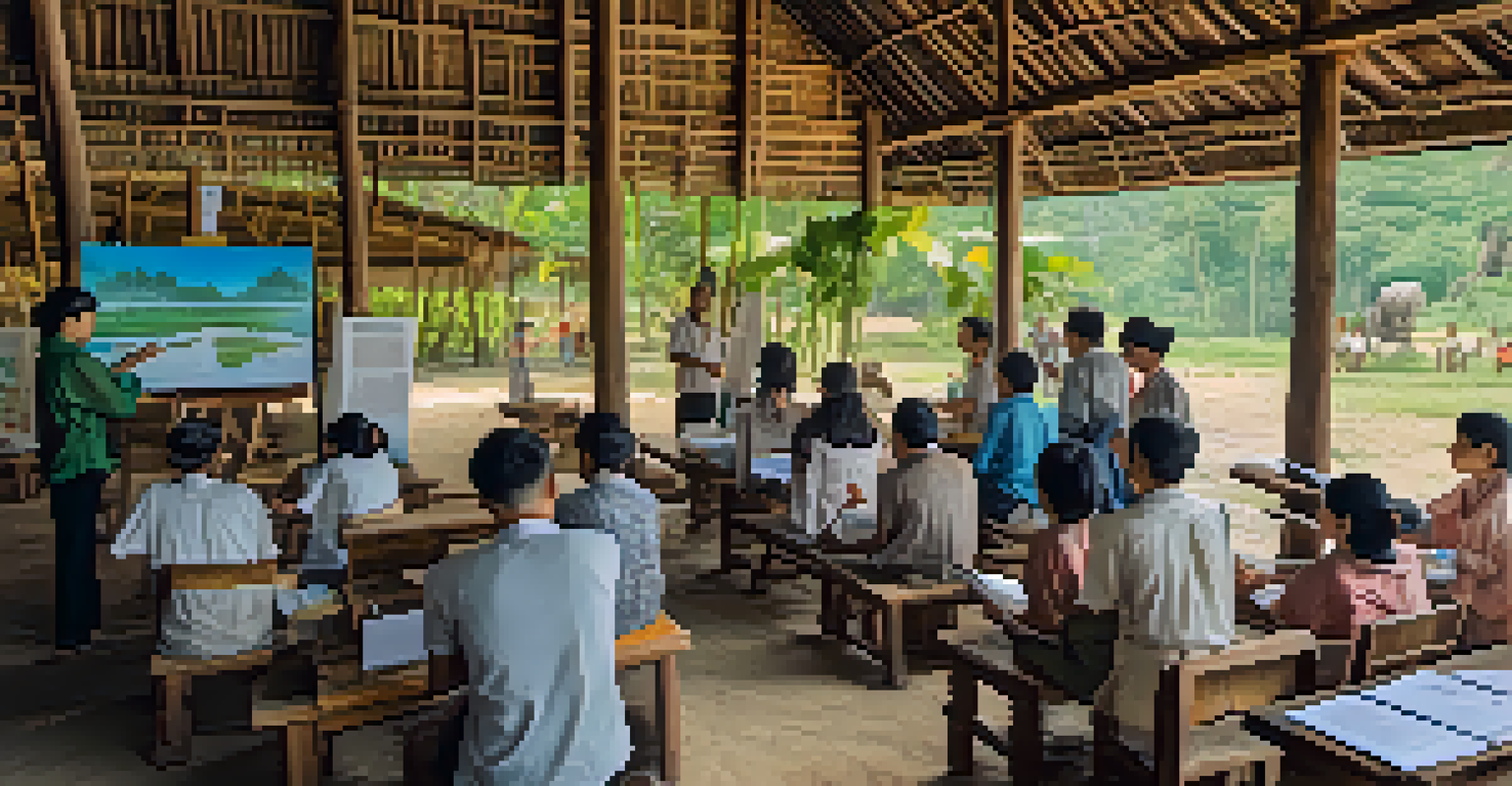The Role of Local Communities in Thailand's Wildlife Conservation

Understanding the Importance of Local Communities
Local communities play a crucial role in wildlife conservation efforts in Thailand. They are often the first line of defense against poaching and habitat destruction, as they live in close proximity to wildlife. By leveraging their knowledge and connection to the land, these communities can effectively monitor and protect local ecosystems.
The future will be shaped by how we respond to the challenges we face in our communities, and our connection to the environment is at the heart of that response.
When locals are involved in conservation, they bring invaluable insights about animal behavior and environmental changes. This grassroots knowledge can help tailor conservation strategies that are culturally appropriate and effective in specific areas. Moreover, their deep-rooted understanding of the landscape fosters a sense of responsibility and stewardship towards nature.
Related Resource
In essence, local communities serve as custodians of their environment. Their participation not only enhances conservation outcomes but also ensures that the strategies implemented respect local customs and livelihoods. When communities feel valued in conservation efforts, they are more likely to support and sustain these initiatives.
Community-Based Conservation Initiatives
Community-based conservation initiatives are programs that empower local populations to manage and protect their natural resources. In Thailand, these initiatives have seen success in various regions, encouraging local inhabitants to engage in wildlife protection actively. For instance, eco-tourism projects allow communities to benefit financially from preserving wildlife instead of exploiting it.

These initiatives often include training locals in sustainable practices, promoting eco-friendly tourism, and providing alternative livelihoods. By involving communities in decision-making processes, they become invested stakeholders in conservation efforts. This sense of ownership can lead to more effective and sustainable outcomes, as community members are more likely to adhere to agreed-upon practices.
Local Communities Are Key to Conservation
Local communities in Thailand are essential in wildlife conservation as they provide critical knowledge and a sense of stewardship toward their environment.
Furthermore, successful community-based initiatives can inspire replication in other regions. They showcase the importance of integrating local knowledge, culture, and economic needs into conservation efforts. By demonstrating tangible benefits, these models can encourage broader participation in wildlife conservation across Thailand.
The Role of Education and Awareness
Education and awareness are vital components in fostering a conservation mindset within local communities. Many organizations in Thailand conduct workshops and outreach programs that educate residents about the importance of biodiversity and sustainable practices. These efforts help to bridge the gap between traditional practices and modern conservation needs.
If we want to make a difference, we must first empower local communities to be the stewards of their own natural resources.
When communities understand the ecological significance of wildlife and their habitats, they are more likely to engage in protective actions. Educational programs can also empower locals to become advocates for their environment, encouraging them to take a stand against illegal activities such as poaching. Knowledge is a powerful tool that can transform attitudes and behaviors towards wildlife conservation.
Related Resource
Moreover, awareness campaigns can also extend beyond local communities to tourists and broader society. By highlighting the interconnectedness of human health and environmental well-being, these campaigns can foster a culture of respect and appreciation for nature. This collective effort is essential for building a sustainable future for both wildlife and communities in Thailand.
Challenges Facing Local Communities
Despite their crucial role, local communities in Thailand face numerous challenges in wildlife conservation. One significant issue is the ongoing pressure from industrial development, agriculture, and urbanization, which threaten natural habitats. As communities navigate these pressures, they often find themselves in a conflict between economic needs and environmental conservation.
Additionally, lack of resources and support can hinder local conservation efforts. Communities may struggle with limited access to funding, training, and technology needed for effective wildlife management. Without adequate support, their ability to implement and sustain conservation initiatives can be severely compromised.
Empowerment Through Community Initiatives
Community-based conservation initiatives empower locals to manage natural resources, fostering ownership and sustainable practices.
Moreover, there can be a disconnect between government policies and local realities. Policies may not always reflect the needs or knowledge of the communities most affected by wildlife conservation strategies. Bridging this gap is essential for creating collaborative approaches that empower locals and protect biodiversity.
The Impact of Traditional Practices
Traditional practices can significantly contribute to wildlife conservation in Thailand. Many indigenous communities have sustainable practices deeply rooted in their cultures, which promote harmony with nature. These practices often include rotational farming, sacred groves, and traditional hunting methods that prioritize sustainability and respect for wildlife.
By recognizing and integrating these traditional practices into modern conservation efforts, we can create more effective strategies that resonate with local communities. For example, some conservation projects have successfully incorporated traditional ecological knowledge, leading to innovative solutions that protect biodiversity while respecting cultural heritage.
Related Resource
Additionally, celebrating and preserving these traditional practices can enhance community pride and identity. It fosters a sense of belonging and responsibility towards their natural surroundings, encouraging locals to be proactive in conservation. This blend of tradition and modernity can pave the way for a more inclusive approach to wildlife protection.
Collaboration with NGOs and Government
Collaboration between local communities, non-governmental organizations (NGOs), and government agencies is essential for successful wildlife conservation in Thailand. NGOs often provide the necessary resources, training, and expertise to empower communities. These partnerships enhance the capacity of local populations to manage their natural resources effectively.
Moreover, such collaborations can lead to the development of policies that reflect the voices and needs of local communities. When communities are included in the decision-making process, it fosters a sense of ownership and accountability. This can result in more effective and sustainable conservation efforts that benefit both wildlife and human populations.
Education Drives Conservation Engagement
Education and awareness programs are vital in shaping a conservation mindset, encouraging local communities to protect their wildlife and habitats.
Furthermore, these partnerships can help raise awareness and attract funding for conservation initiatives. By showcasing the success of collaborative projects, they can inspire further investment and support from both local and international stakeholders. This united approach is crucial for tackling the complex challenges facing wildlife conservation today.
Success Stories of Community-Led Conservation
There are inspiring success stories of community-led conservation in Thailand that highlight the potential of local involvement. For instance, the Huay Kha Khaeng Wildlife Sanctuary has seen local communities engaged in monitoring wildlife and protecting their habitats. Through community patrols and education programs, these locals have significantly reduced poaching incidents.
Another remarkable example is the work being done in the Khao Sok National Park, where local communities have developed eco-tourism ventures. These initiatives not only provide financial benefits but also promote conservation awareness among visitors. By showcasing their culture and natural beauty, communities are creating a sustainable economy that supports wildlife preservation.

These success stories serve as powerful examples of what can be achieved when local communities are empowered to take charge of their conservation efforts. They demonstrate that with the right support, communities can develop innovative solutions that protect both their livelihoods and the environment. Such examples inspire hope and encourage others to follow suit in the journey toward sustainable wildlife conservation.